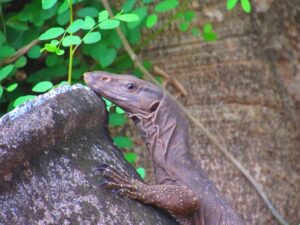Physical Address
23,24,25 & 26, 2nd Floor, Software Technology Park India, Opp: Garware Stadium,MIDC, Chikalthana, Aurangabad, Maharashtra – 431001 India
Physical Address
23,24,25 & 26, 2nd Floor, Software Technology Park India, Opp: Garware Stadium,MIDC, Chikalthana, Aurangabad, Maharashtra – 431001 India

Sri Lanka, an island nation renowned for its rich biodiversity, is home to a diverse array of tropical reptiles. From the majestic Sri Lankan Monitor Lizard to the elusive Green Pit Viper, these species play crucial roles in their ecosystems. However, the escalating impacts of climate change pose severe threats to these reptiles, disrupting their habitats, behavior, and survival.
Changes in Rainfall and Monsoonal Patterns
Recent studies have highlighted significant shifts in Sri Lanka’s monsoon patterns, including reduced rainfall frequency, drier periods, and increased intensity of extreme rainfall events. These changes affect moisture regimes crucial for reptile embryonic development. For instance, freshwater turtles and crocodiles rely on moist, well-drained soils or proximity to large water bodies for nesting. The observed drying trends may lead to egg dehydration, reducing hatching success and affecting hatchling size and survival.
Affected Species:
Effects of Air Temperature Increments
Tropical reptiles, which live close to their physiological thermal optima, are particularly susceptible to temperature increases caused by climate change. Higher temperatures can boost metabolic rates by 10-75%, reducing foraging time and impacting population growth rates. While some species might benefit from warmer temperatures, the overall effect is negative, with habitat fragmentation and natural barriers limiting migration to cooler areas. Behavioral and physiological plasticity may help some reptiles cope with rising temperatures. Still, the rapid pace of climate change may exceed their adaptive capacity. Increased temperatures also affect reptile interactions with predators and their ability to perform essential activities like foraging and mating, further threatening survival. Read more
Effects of Climate Warming During Embryonic Development
Climate warming profoundly impacts reptile embryos by altering nest conditions. Higher temperatures can affect incubation duration, embryo survival, and hatchling traits such as size and behavior. Species with temperature-dependent sex determination (TSD) may experience skewed sex ratios, affecting reproductive dynamics. Read more
Notable Species:
Effects of Sea Level and Temperature Increase on Aquatic Reptiles
Rising sea levels and water temperatures impact aquatic reptiles, including marine turtles and crocodiles. For instance, warmer sea temperatures have led to changes in nesting behaviors and reproductive seasons in sea turtles. In contrast, rising sea levels in Sri Lanka have increased salinity and human-crocodile conflicts. Read more
Affected Species:
Temporal Patterns of Snakebite in Sri Lanka and Climate Change
Snakebite incidents in Sri Lanka exhibit distinct seasonal patterns, with peak occurrences typically from November to December, followed by March to May and August. Fluctuations influence this seasonality in relative humidity, where lower humidity levels are linked to increased snakebite incidents. Projections suggest climate change could elevate the annual snakebite burden by approximately 31.3% over the next 25-50 years. As climate change continues, the frequency of snakebites is expected to rise, particularly during periods of lower humidity. Read more
Distribution Status and Climate Change Impact on Hornbills in Sri Lanka
Climate change significantly affects the distribution patterns of hornbills in Sri Lanka. Utilizing field observations and e-bird records, the study reveals that the ecological niches for hornbills, specifically Ocyceros gingalensis and Anthracoceros coronatus, are shifting due to climate changes. Anthracoceros coronatus faces a critical reduction in its predicted habitat, necessitating targeted conservation efforts. In contrast, Ocyceros gingalensis shows relatively stable habitat predictions in the wet zone. The study emphasizes the need for conservation strategies considering climate change’s influence on species distribution. Read more
Conclusion
The diverse reptile species of Sri Lanka, ranging from terrestrial and arboreal lizards to aquatic crocodiles and turtles, are increasingly threatened by the impacts of climate change. As highlighted by local research and experts, the rising temperatures, altered rainfall patterns, and sea level changes are not just altering habitats but are fundamentally disrupting the delicate ecological balance these species depend on. The adverse effects on embryonic development, shifts in behavior, and increased risks such as dehydration and altered sex ratios underscore the complex challenges ahead. Additionally, the increased incidence of snakebites and the shifts in species distributions highlight broader implications for human-reptile interactions and conservation efforts. To safeguard Sri Lanka’s reptile biodiversity, it is imperative to implement targeted conservation strategies that consider the dynamic and evolving nature of climate change. This includes habitat restoration, mitigating human-wildlife conflicts, and continuous monitoring of these vulnerable species. Protecting these reptiles is crucial for their survival and maintaining the integrity and health of Sri Lanka’s rich ecosystems.
References:
https://www.frontiersin.org/journals/ecology-and-evolution/articles/10.3389/fevo.2021.688723/full#F2
https://academic.oup.com/ije/article/47/6/2049/5094971
https://www.mdpi.com/2225-1154/8/4/51
https://royalsocietypublishing.org/doi/abs/10.1098/rsbl.2017.0002
https://journals.biologists.com/jeb/article-abstract/220/12/2159/34100
https://zslpublications.onlinelibrary.wiley.com/doi/10.1111/jzo.12460
https://reptile-database.reptarium.cz/species?genus=Crocodylus&species=porosus
Images
Banner: Photo by Atharva Kanekar on Unsplash